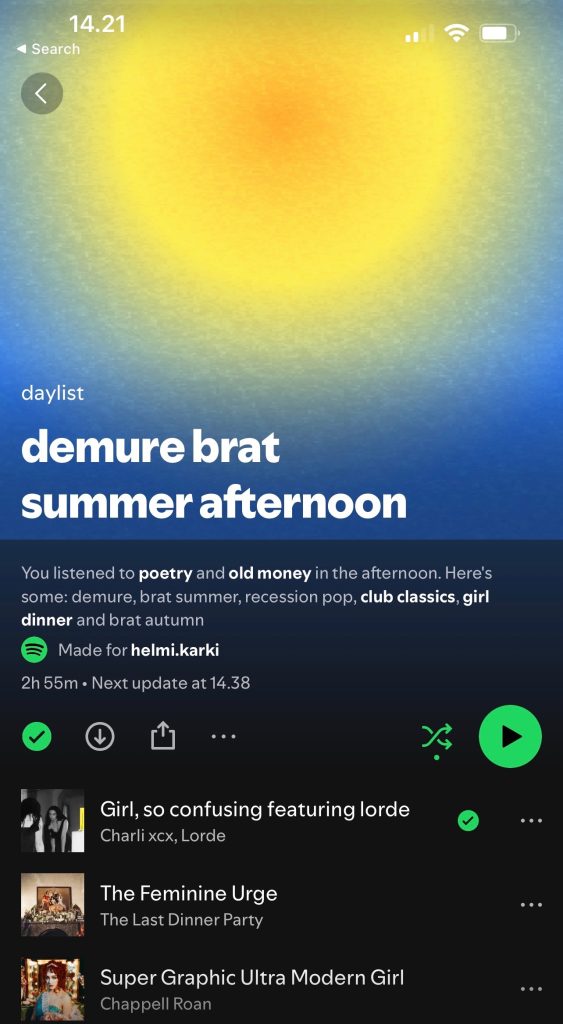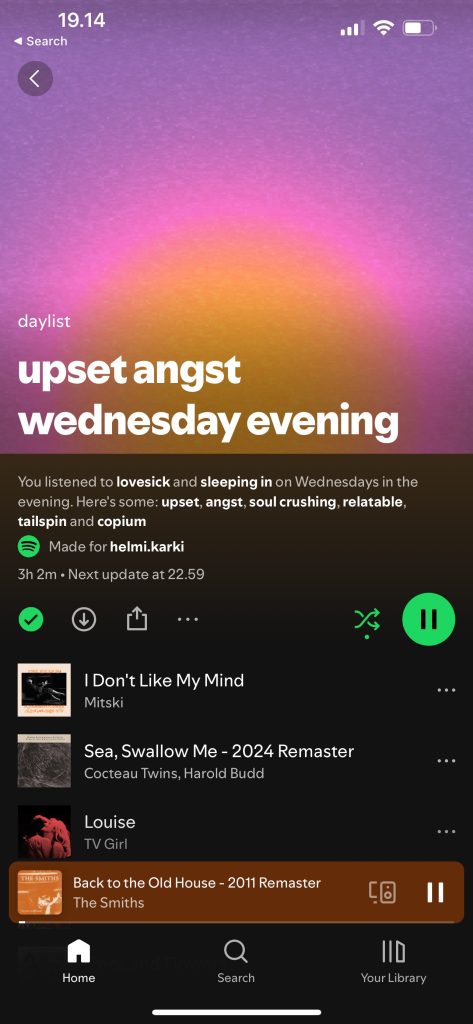Although Spotify has been the leading music streaming service for approximately the past decade, it still continuously releases new updates. But maybe the updates are not released despite the dominant position of the platform, maybe this constant updating is the reason why Spotify has such a tight grip on its audience. A great contributor to the addictiveness of the platform is its extreme personalization. Spotify’s user-based collaborative filtering algorithm curates hyper-individualized listening experiences without the need for the consumer to necessarily choose the songs they wish to listen to themselves.
The newest major update and the next step on the path of Spotify’s hyper-individualization is the Daylist. The Daylist is a playlist created by the algorithm that changes both its names and its songs every few hours. The playlist is created based on the information of what type of music the consumer listens to at a certain time of a certain day of the week, for example, Thursday afternoon or Sunday morning.
The Daylist has fascinated me since its release. I find the absurdity of its changing names amusing, and I see the way it speaks directly to me as slightly creepy. Occasionally the collected songs manage to create an extremely specific mood together, it is as if I would have personally chosen them. Additionally, just the reminder that Spotify remembers what type of music I have listened to at the same hour during the past weeks sends shivers down my spine. It works as a reminder of how every time I just innocently wish to hear a song, the application collects data on my preferences and possibly makes other assumptions based on it.
For the past few weeks, I’ve been screenshotting the absurd names of these lists for very scientific purposes. My first observation was how these names often rely heavily on online trends. This is an obvious strategy to attract young audiences to start listening to these generated lists. Some examples of trendy keywords used in my Daylists are brat summer, girl dinner, and demure.


To track your individual consumption habits, Spotify has created its own music genres that do not exist outside the platform. These genres aim to capture extremely specific moods and sounds, the songs included in some of the playlists Spotify has created for made-up genres are representatives of real already existing genres of music. Under the name of the Daylist, there is a short text in fine print explaining how the algorithm ended up creating this specific list for you. It mentions two music genres you supposedly listen to during this specific time of the week and tells you which genres it is therefore presenting to you now. Most of the names of the music genres have been written in bold letters. These names are hyperlinks to playlists including songs of the specific genre.


Although this attempt at hyper-individualized marketing is most often shockingly apt, this experiment seems to still be in its infancy. Most of these so-called genres are nearly the same; the same songs are included in multiple supposedly different genres. What I’ve noticed is that quite often these playlists recommend a great deal of the same songs. The songs just get rebranded with the change of the playlist’s name. This same phenomenon causes a problem when it comes to the way the algorithm recommends playlists that are made by other Spotify users. Whenever I manually search for new playlists on Spotify, the ones that are recommended for me mostly include songs that I have already liked or saved. Due to this, I end up listening to the same set of songs again and again, the name and thumbnail of the playlist just change. I am not saying I would not have found new songs through playlists made by other Spotify users or even through the Daylist, I am just trying to emphasize how frustrating the manner in which the algorithm functions can be. It is easy to create an accidental bubble for oneself through surrendering to this loop.


I find it annoying that Spotify creates new names for music genres by referencing whatever is trending online because, as you mentioned, usually multiple of these ‘genres’ describe the same music. They become umbrella terms with no actual meaning, and while it’s entertaining to look both at the randomness and accuracy of my daylists’ descriptions, it is so obvious that it is simply a marketing tactic to reach young people that I find it very superficial. I think it could work if Spotify put more effort into making sure those names have any connection with the music they describe. Otherwise, I see it as a rather lazy attempt to attract young generations. PS. apparently I listen to ‘horror gaming’ in the evening